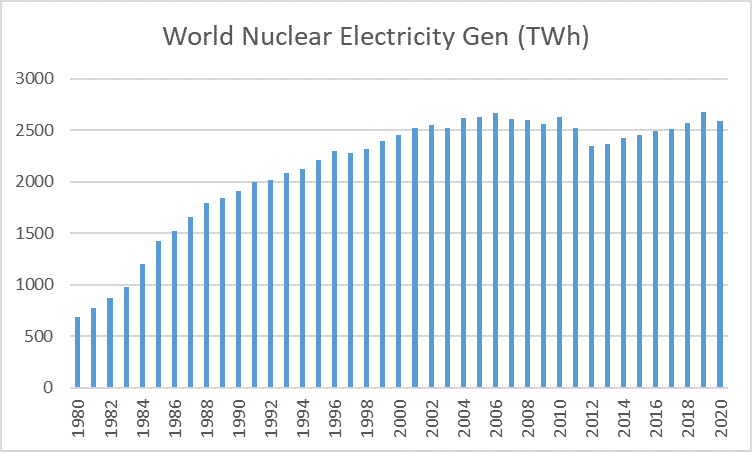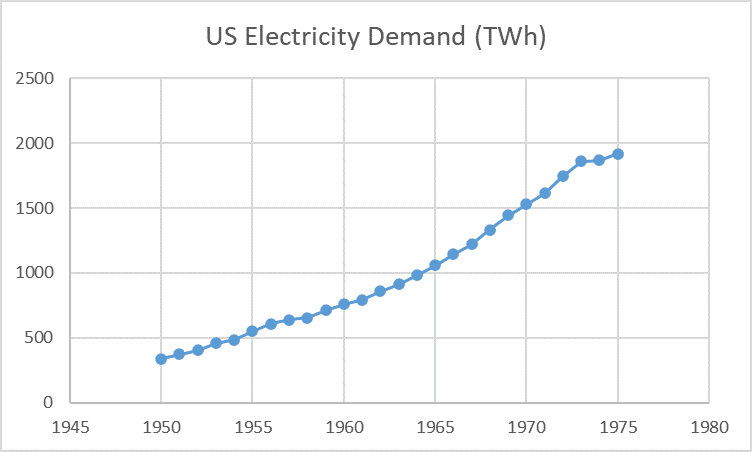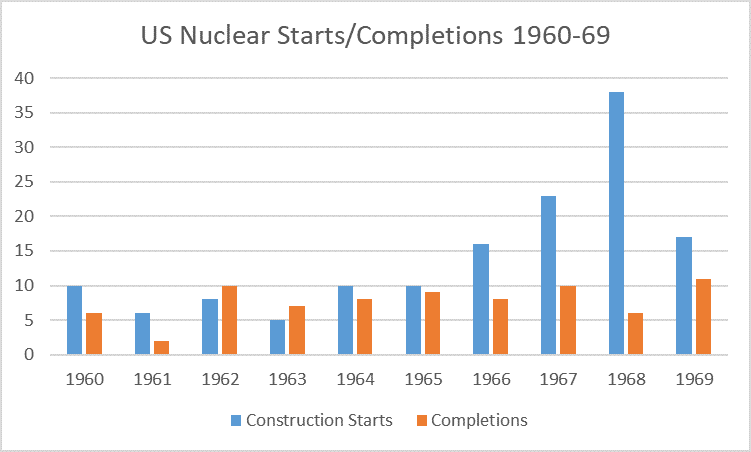Calling to mind the Manhattan Project, Nixon wanted 1,000 nuclear plants to be built by 2000.
- Those 1,000 plants would have provided 200% of the U.S.’s power needs… in 2022.
No coal, no wind, no solar, no natural gas, no hydro. No carbon emissions. Just 100-percent-clean, made-in-America nuclear power.
Like others of his time, President Nixon saw the incredible promise held in the atom.
Nuclear power plants use tiny amounts of uranium, an abundant natural resource, as fuel. That means they only have to be refueled every 1.5 years.
And because uranium is extremely energy-dense, the mining impacts are minimal compared to coal, oil… even wind power.
Nuclear produces zero pollution from operations. It doesn’t care if it’s windy or sunny or rainy. It just goes—operating more than 90 percent of the time.
Best of all, nuclear provides massive amounts of baseload power—about 1GW per reactor. That makes a single two-reactor plant capable of powering more than one million homes.
By every possible metric, nuclear is the best, most reliable source of carbon-free energy on the planet.
It should be powering much more of the planet. But it isn’t.
In fact, nuclear power has been stagnant for the past thirty years… and declining for the past decade.
In the United States, zero nuclear power plants ordered since 1972 have been completed. And nuclear provides only 20 percent of electricity in the United States.
As nuclear power plants reach the end of their forty-year lifespans, one by one, the lights are going out all around the world.
Which begs two questions:
- If nuclear power is so star-spangled awesome, then how exactly did it end up on life support? And when—if ever—is that going to change?
The Nuclear Boom That Went Out with a Bang
Twenty-five years before Nixon famous speech, the Atomic Energy Commission (AEC) had funded four different types of “atomic piles,” as experimental nuclear reactors were then called.
Their purpose was not to generate massive amounts of power. The AEC was just throwing atoms at the wall to see what would stick.
Because of World War II, AEC worked mostly in secret—few in the outside world had even heard of nuclear power.
That changed suddenly in 1953. President Eisenhower decided the world needed to know the vast energy potential held by the atom.
It was time for the U.S. to reorient its research efforts from using atomic energy for destructive purposes and toward generating electricity.
So Eisenhower went before the United Nations in New York City and delivered a powerful speech titled “Atoms for Peace.”
When he finished, the entire chamber leapt to its feet, giving Eisenhower a 10-minute standing ovation.
- In just a few moments, the President had set in motion decades of civil nuclear energy development in the U.S.
It was an Atomic Race of sorts, with the U.S. vying with other countries to create a civilian nuclear power sector as quickly as possible.
The following year, the AEC announced a government-sponsored five-year plan to explore various types of commercial nuclear reactors to find the best one. Every configuration of coolant and fuel and system had to be tried in order to identify a safe, economical nuclear system.
Early projects were extremely expensive.
But within a decade, GE and Westinghouse, figured out how to build giant, economical light water reactors (LWRs).
That move kicked off what is now known as “The Great Nuclear Bandwagon.”
GE and Westinghouse sold dozens of turnkey plants in just four years—without any subsidy from the government.
It was a daring effort to jumpstart a global commercial nuclear power market.
And it worked.
More than 100 reactor orders were placed to meet the growing electricity demand.
And two years later, nuclear power plants were being sold at costs that were competitive with fossil-fuel plants.
Construction costs for new reactors dropped to $600–$900/kW in today’s dollars.
- For context, that’s cheaper than modern gas plants.
With energy that cheap, nuclear business boomed, spreading across the U.S.—and the world—like wildfire.
Just as soon as it started, it was over. By the early ‘70s, many utilities stopped ordering new reactors and cancelling in-progress projects.
By 1980, nuclear plant orders had come to a dead halt.
The Four Bogeymen of the Nuclear Boom
On its rocket-ship trajectory from Eisenhower’s speech to executing Nixon’s Project Independence, nuclear power faced five major problems.
The first of those was public perception. Nuclear’s initial downfall was orchestrated by radical environmentalists who stirred up hysteria against nuclear plants.
Starting in the ‘60s, they waged a well-funded, well-organized War on Nuclear.
Their work caused strict regulations to be passed. The resulting high prices—especially compared to other forms of energy—caused nuclear projects to be cancelled or decommissioned.
They were benefited by declining energy costs from other forms of energy like coal and gas, which made nuclear uneconomical.
Then there was the problem of waste management. There was no federal program for storing the small amounts of radioactive waste created by nuclear power.
Then, two high-profile nuclear accidents—Three Mile Island and Chernobyl—confirmed the public’s safety concerns with nuclear energy.
With public support plummeting, countries like Austria made nuclear power illegal.
But over the past few decades, the real horseman of the apocalypse has come riding in: climate change.
While countries like Austria and Germany are struggling to meet carbon emissions reduction targets with intermittent wind and solar, the wind is shifting in another direction.
- Public perception toward nuclear is rising just as fast as the temperature
- The price of new nuclear reactors is dropping thanks to modular innovations
- The price of natural gas has more than quadrupled in one year
- Several countries have figured out efficient, long-term waste storage solutions
- And nuclear reactors have become the safest form of energy on the planet.
It’s not a moment too soon.
The International Energy Agency says that the nuclear industry will need to double in size over the next two decades for us to meet net zero emissions targets.
There are just over 400 nuclear reactors in operation around the world right now.
Looks like Eisenhower made the right move.
And Nixon might have been ahead of his time when it comes to nuclear power.
Carboncredits.com receives compensation for this publication and has a business relationship with any company whose stock(s) is/are mentioned in this article.
Additional disclosure: This communication serves the sole purpose of adding value to the research process and is for information only. Please do your own due diligence. Every investment in securities mentioned in publications of carboncredits.com involves risks that could lead to a total loss of the invested capital.



